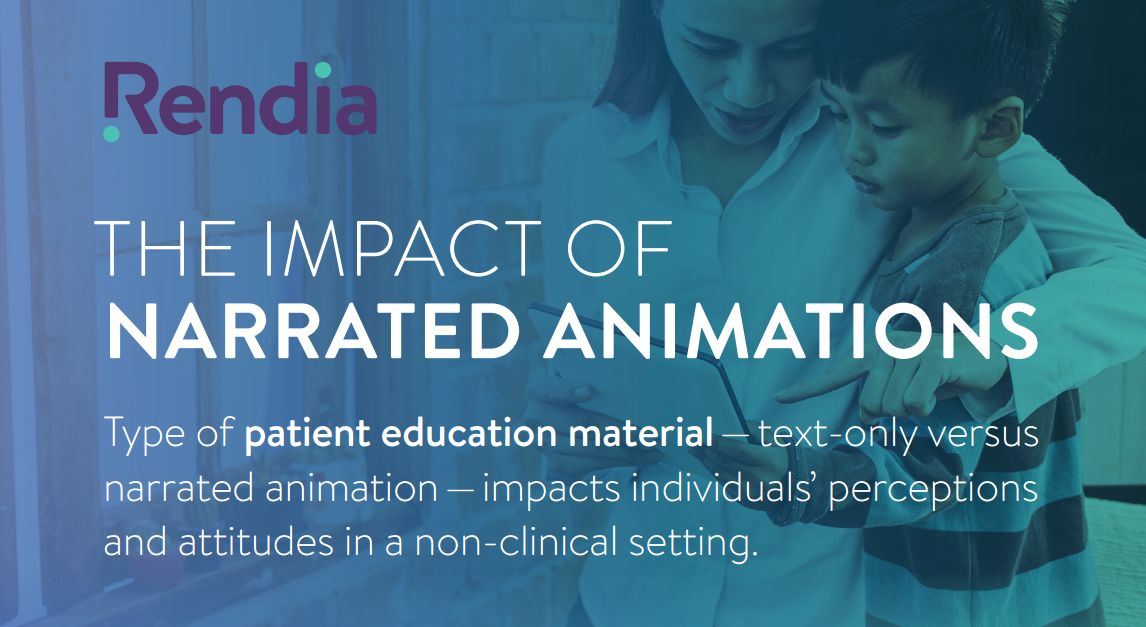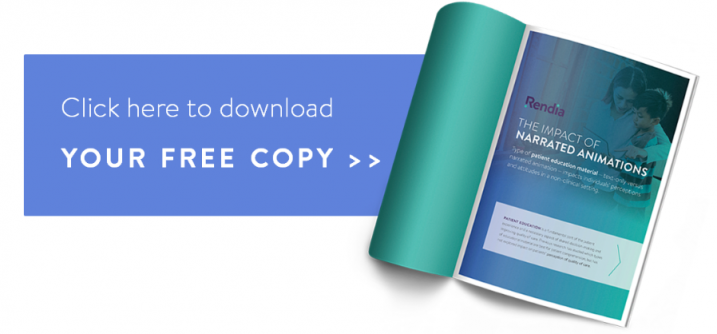Is your patient education making you look bad? New study reveals impact on patient perception
Substantial research has been done to evaluate what types and methods of patient education are most easily understood by health care consumers. While comprehension is certainly important, it’s not the only measure of educational materials’ impact. Ultimately, patient education has the power to affect health outcomes and patient experience—and even whether patients will refer friends and family to their doctor.
Educational materials affect how patients perceive their ability to manage their own health, as well as how they feel about their doctor and their likelihood of recommending him or her.
To measure this, researchers at Rendia conducted a randomized study to evaluate whether the type of educational materials impacts patients’ perceptions, attitudes, and intended health behaviors. Comparing two common patient education methods—text-based versus narrated animation—the study assessed how each one affected respondents in the following ways:
- perceived quality of the information;
- feelings towards their provider;
- perceived ability to manage their own health; and
- likelihood of recommending their doctor, among other factors.
For a quick overview of the results, check out our infographic here.
The data from this study suggest that the type of patient education materials does make a difference—in some cases, a significant one. Read on to find out where most patient education falls short, what methods are showing promise now, and how you can get a copy of the complete survey results for yourself.
The problem with verbal explanations
Although historically, verbal explanations and print materials have been the primary forms of patient education, these methods are problematic. Verbal-only explanations are not ideal because health care providers often use complex language or scientific terminology—“medicalese”—that patients don’t understand. Or, they may use broad generalizations that do not adequately explain a specific patient’s condition.
Also, studies show that most patients forget most of what their doctor tells them during appointments. Last year, the New York Times reported that “in over 60 percent of cases, patients misunderstood directions after a visit to their doctor’s office.”
How text-based materials fall short
Text-based materials such as pamphlets and brochures are often provided to patients. However, health literacy is a big issue in the US. A review of patient education materials in ophthalmology found that most are consistently written at a level that is too high for patients to understand.
Even many online patient education materials from major medical associations are not written at a level appropriate for the average American, and patients are both using and being referred to these materials by their doctors.
Text-based patient education materials don’t serve visual learners, an estimated 65 to 85 percent of the population.
Written materials also don’t take into account visual learners, estimated to comprise between 65 to 85 percent of the population. These are people who retain information better by seeing pictures and videos rather than reading text or hearing information delivered orally.
Videos show promise
Research has demonstrated value in using multiple methods to convey information to patients. This could be a combination of verbal instructions and printed information sheets or pamphlets, or videos that illustrate medical concepts while providing narrated and/or text accompaniment.
The best way to communicate complex health information to all patients? Spoken animation.
A recent study found that spoken animation is the best way to communicate complex health information to people with low health literacy, while not negatively influencing people with high health literacy.
Why type of patient education matters more than ever
In this new health care climate, doctors are under increasing pressure to improve quality of care while simultaneously lowering costs. At the same time, patient satisfaction scores are being factored into provider reimbursements.
If you get the patient education piece right, the rest of the puzzle falls into place.
Numerous studies have linked doctors’ empathy to patient satisfaction, and patient education to perceived physician empathy as well as improved patient satisfaction. If you get the patient education piece right, it seems, the rest of the puzzle falls into place.
In the results of The Impact of Narrated Animations study, you’ll find out:
- What type of patient education materials generate higher quality ratings
- The significant findings that have an impact on patient loyalty and perception of care
- The real reason you may not be getting referrals from your patients
- How the type of patient education you provide can help or hinder your patients’ behavior and outcomes


